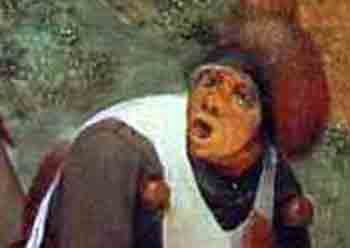
Recovery
 THE STRESS-EMOTIONS CONNECTION
THE STRESS-EMOTIONS CONNECTION

Feel an episode coming on? You're probably experiencing major stress.
by John McManamy

Feel an episode coming on? You're probably experiencing major stress.
by John McManamy
VERY RECENTLY, a good friend of mine posted on Facebook a story from the London Telegraph, bearing this headline: “Mental illness mostly caused by life events not genetics, argue psychologists.”
According to the article:
Mental illness is largely caused by social crises such as unemployment or childhood abuse and too much money is spent researching genetic and biological factors, psychologists have warned.
Moreover:
While there has been some success in uncovering genes which make people more susceptible to various disorders, specialists say that the true causes of depression and anxiety are from life events and environment, and research should be directed towards understanding the everyday triggers.
There we go. Had I only decided to become an accountant or take up the accordion instead of becoming a journalist, I never would have flipped into mania.
Actually, this is probably true, but that is hardly the whole story. The impression we get from this article is that genes and the environment are two separate entities, as if completely divorced from one another, as if our behavior and mental illness stem from two entirely unrelated sources - genes OR environment.
Moreover, it raises the same old tired nature vs nurture debate, replete with the mistaken notion that one perspective has to be completely true while the other has to be completely false. But scientists speak a very different language. As Robert Sapolsky of Stanford University, who has researched extensively on the impact of stress on animal and human behavior, put it in a 1997 article in Discover Magazine:
The biological factors that genes code for in the nervous system typically don’t determine behavior. Instead they affect how you respond to often very subtle influences in the environment. There are genetic vulnerabilities, tendencies, predispositions - but rarely genetic inevitabilities.
This view is given strong support in a landmark study published in Science in 2003. The study had its roots in a "birth cohort" of more than 1,000 infants born in Dunedin, New Zealand in 1972-73.
Had my daughter (who was born in Dunedin) arrived five years earlier, she might have been part of that cohort. Then again, had she been born five years earlier, I wouldn't have been the father.
Three decades into the study, researchers led by Avshalom Caspi of King's College surveyed this now adult cohort for recent stressful events in their lives, such as death in the family, losing a job, or breakup with a partner. Then they checked the results against two versions of a particular gene - SLC6A - that regulates the production of the neurotransmitter serotonin.
The differences related to the “promoter” region of this particular gene, which essentially flips the on switch. The short version - “allele” - of the promoter has 14 repeat sequences, the long allele 16. If you’re a short allele person, this translates to your neurons producing less serotonin. This may be perfectly fine if you lead a relatively stress-free life, but introduce unwanted drama into your world and the lack of those two extra repeat sequences may frustrate your best efforts to manage the situation.
As it turned out, those with the short allele were more than twice as likely to experience stress-induced depression as those with the long allele.
As I heard Daniel Weinberger of the NIMH, who took part in a related study, describe it at the American Psychiatric Association annual meeting that same year, this particular gene "impacts on how threatening the environment feels."
Writing in the American Journal of Psychiatry at around the same time, Dr Sapolsky explained that the genetics of many psychiatric disorders are based on "if-then" logic. For instance, given certain gene variations, “IF you are exposed to a stressful life event, THEN your risk of depression increases," to the more complex, “IF you are exposed to a stressful life event AND you have a low sense of self-efficacy, THEN your risk of depression increases.” (Caps added by this writer.)
SIGN UP FOR MY FREE EMAIL NEWSLETTER
We can easily fill in our own blanks here and add an extra layer or two of complexity to get a more complete story. In my case, having regard to a certain manic episode, given certain gene variations: “IF you are exposed to a stressful life event AND you feel a certain level of discomfort around people, AND you drive yourself too hard, THEN your risk of flipping out increases.”
We can even get a bit creative, as in …
Given the fact that I have a brain that should have been returned to the customer service counter of life five minutes after I was born: IF I decide to take up journalism instead of the accordion AND had I not bonded with a nun in the maternity ward instead of my mother AND if I decide to push my luck being outgoing among people rather than contemplating the pronunciation of “eschatological” in a Trappist monastery THEN my life will crash and burn with the inevitability of a plane taking off on a too-short runway in a low-altitude wind shear.
There is no Owner’s Manual for this sort of thing. Typically, we learn from bitter experience. To give the Telegraph account its due, this is what their article was driving at - that we need more research to understand these everyday triggers. In the meantime, we need to be our own experts. If we are seeking to make decent headway in our recovery, we need to be nerds and geeks about this sort of thing.
From a Rodent's Perspective
When it comes to studying humans, rats and mice serve as admirable stunt doubles. You may not be able to exactly ask a rat how it’s feeling, but treat the poor creature miserably - remove it from from its mom, shock it, prod it, toss it in water, suspend it by its tail, place it in a crowded cage, drop it in an open space, run it through mazes, play it Kenny G music - and simply observe what happens.
Now do the same thing to a human kid: Expose him to abuse and deprivation, ship him off to fight in a foreign war, place him in a toxic work environment, throw in the relationship from hell, rain down financial worries, make him jump through hoops, play him Kenny G music - and see what happens.
Expose any mammal - four-legged or two-legged - to that kind of abuse and see what happens. The early DSMs – the supposedly pre-science Freud-based ones – actually reflected that point of view. Thus, according to the DSM-I of 1952, our so-called reactions “are as much determined by inherent personality patterns, the social setting, and the stresses of interpersonal relations as by the precipitating organic impairment.”
The only part of this sentence that needs fixing is the bit about organic impairment. Here, to its credit, the DSM-I at least acknowledged the biological component to mental illness, but it erred in viewing it as a separate phenomenon. It was as if the mind were an entity distinct from the brain, and the brain were some mysterious black box.
Back in 1915, the Harvard physiologist Walter Cannon came up with the concept of “fight or flight.” Building on that, the Austrian-Canadian endocrinologist Hans Selye hit upon an accidental discovery.
As a dutiful but clumsy young medical student in the 1920s, Selye kept dropping the rats he handled and was forced to chase them around the lab with a broom.
Little did he know that he was conducting his own pioneering experiments. As it turned out, the badly stressed rats that wound up on his dissection table had larger adrenal glands and smaller lymphatic structures, plus peptic ulcers. At first Selye thought he had discovered a new hormone, but when he compared his poor rats to a batch he hadn’t had a chance to drop, he knew he was onto something new. Such is the nature of scientific discovery.
Over the decades, with the rat as his principal lab partner, Selye would map the hypothalamic-pituitary-adrenal axis system (HPA axis) - the neuroendocrine pathway responsible for pumping adrenaline and glucocorticoids into the bloodstream and thus activating the body’s fight or flight response.
In 1936, he identified “general adaptation syndrome,” which broke down the stress response into three stages: Alarm (involving fight or flight), resistance (involving attempts to adapt to continued stress), and exhaustion (where illness sets in).
In the 1960s, Paul MacLean of the NIMH identified the brain’s lower mammalian layer as the “limbic system,” involved in the processing of emotions, as opposed to the cortical layer associated with higher functions.
From there, starting in the 1980s, Joseph LeDoux of NYU zeroed in on the limbic system’s amygdala and mapped its incoming connections from various sensory and cognitive pathways and out via other pathways into the cortex, basal ganglia, and HPA axis. Working with rats, Dr LeDoux successfully implicated the amygdala in the processing of arousal and fear and anger.
This stress response - fight or flight - kept our distant ancestors alert and alive long enough to pass on their genes, which certainly comes in handy in modern life, especially when a zeppelin is chasing you. As Kurt Vonnegut describes it in his 1973 novel, "Breakfast of Champions":
My mind sent a message to my hypothalamus, told it to release the hormone CRF into the short vessels connecting my hypothalamus and my pituitary gland.
The CRF inspired my pituitary gland to dump the hormone ACTH into my bloodstream. My body had been making and storing ACTH for such an occasion. And nearer and nearer the zeppelin came.
And some of the ACTH in my bloodstream reached the outer shell of my adrenal gland, which had been making and storing glucocorticoids for such emergencies.
My adrenal gland added the glucocorticoids to my bloodstream. They went all over my body, changing glycogen into glucose. Glucose was a muscle food. It would help me fight like a wildcat or run like a deer.
And nearer and nearer the zeppelin came.
My adrenal gland gave me a shot of adrenaline, too. I turned purple as my blood pressure skyrocketed. The adrenaline made my heart go like a burglar alarm. It also stood my hair on end. It also caused coagulants to pour into my bloodstream, so, in case I was wounded, my vital juices wouldn't drain away.
There you have it. Check out Part II, Social Stress ...
July 9, 2016
NEW!
Follow me on the road. Check out my New Heart, New Start blog.












